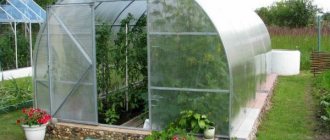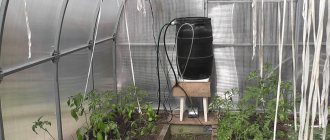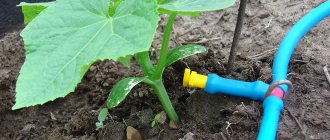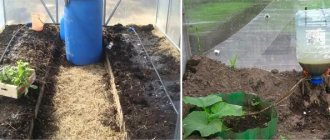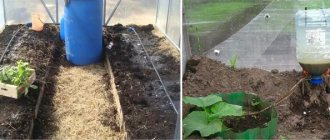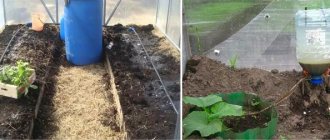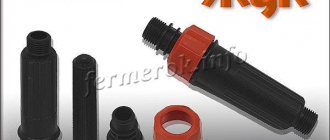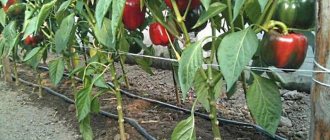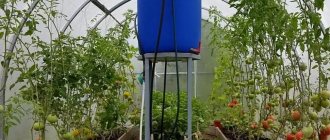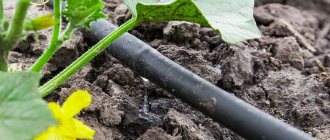Providing water to plants and plantings is one of the concerns of homeowners. Some water the vegetable beds, some water the flower beds and lawns, and some need to provide water for the garden. In any case, the procedure takes quite a lot of time. But that’s not all: with the usual method, a crust forms on the surface, which prevents plants from developing, so you have to loosen the soil. All these problems can be solved by drip watering the plants. You can buy ready-made kits, order turnkey development and installation, or you can do everything yourself. This article will discuss how to make drip irrigation yourself.
Pros and cons of the system
The advantages of a drip irrigation system using medical droppers include:
Cost-effective - the tubes are mounted directly above the root system of each plant, which allows for control over the level of flow of supplied water.- High productivity and yield of plants watered by this method.
- The ability to adjust the supplied water using a wheel on the tube - each plant requires a different volume of water, and when using medical droppers, its amount can be controlled independently.
- Possibility of autonomous irrigation.
- Reducing the growth of weeds on the site.
- Absence of crust on the soil surface.
- Increase in fertility - up to 40%.
- Ensuring soil moisture in large areas subject to minimum pressure in the water supply system.
- Easy to assemble and operate.
The disadvantages of drip irrigation from medical droppers include:
- The main disadvantage is the need for dismantling during the cold season. This is due to the fact that soft plastic at negative ambient temperatures loses its original qualities and can become deformed or damaged.
- The cost of medical products - it may be possible to supply droppers to each plant on a large plot of land.
- The small diameter of the tubes, which without the use of additional filters, often causes blockages in the system.
- Not suitable for watering lawns.
- The need to replace tubes damaged by rodents.
Comments (2)
Nika
11/17/2015 at 00:15 |
I saw with my own eyes what a wonderful way of watering this is. Unfortunately, I’m still pulling hoses, but my neighbor has done drip irrigation. This is a super thing, it makes the work easier, and there are also fewer weeds growing, since you don’t water them.Answer
Yulia Expert Plodogorod
24.10.2018 at 18:51 |
Hello Nika! It is indeed true that this method will not only facilitate the watering process, but will also reduce the number of weeds. But if you want to minimize the fight against unwanted plants in the garden, then you can add the use of agrofibre to the drip irrigation system.
When a gardener decides to modernize the method of moistening the soil by introducing drip systems, regardless of whether they are purchased or homemade, planting needs to be systematized. It is important to maintain strict rows in the beds, otherwise it will be difficult to calculate the holes and lay out the tubes.
Since such work has already been done, why not go further and cover the landing strips with spunbond. For the purpose of getting rid of weeds, be sure to buy black. So, they will not be able to photosynthesize, and accordingly, they will die.
The technology is quite simple: slits are made in the material for cultivated bushes or seedlings, the rest is covered with fabric. This helps harvest crops and control pests. Drip systems are laid on top, since spunbond is capable of transmitting moisture.
For the winter, it is better to remove agrofibre, as well as irrigation pipes. In this case, they will last longer.
Answer
Where can it be used?
A system of medical drippers is optimal for watering plants planted in a row. Can be used to care for:
- any agricultural crops,
- flowers,
- bushes,
- trees,
- grapes
Well suited for watering greenhouses and greenhouse plants. It allows water to be supplied only to the roots of plants, without having a detrimental effect on their trunks and leaves.
It is optimal to use it for watering berries - strawberries, wild strawberries. Medical drippers provide a regular flow of water to the root system under low pressure, preventing root rotting, and can irrigate them autonomously, without the need for human intervention.
The system is also optimally suited for watering indoor plants . For production, medical droppers and a separate container are used - for example, a plastic bottle with a volume of 2-5 liters.
The number of tubes depends on the number of flowers in the pots, because a separate dropper is installed for one plant. The method allows you to automate the irrigation system and prevent excessive moisture from entering the soil, leading to rotting of the root system.
Step-by-step instructions for making your own
To make a do-it-yourself irrigation system from medical droppers, you will need:
A separate container that acts as a water reservoir.- Plastic pipe. It is recommended to use PVC pipes - they have a long service life and no need for maintenance.
- Rubber hose.
- Medical droppers, the number of which is determined by the number of plants.
- Filter – you can use a fine metal mesh.
- Pressure control tap.
- Plugs.
- Corners made of low-density polyethylene (HDPE).
- An awl or drill for making holes in the pipe according to the number of droppers.
- Sealant for treating fastening points in PVC pipes.
How to make a system with your own hands:
- Water tank - for irrigating a vegetable garden or garden plot, it is optimal to use a plastic barrel, which must be installed on a hill. This could be a wooden platform, which will create pressure when water moves, and give it the opportunity to reach remote places in the area with installed medical droppers. The more plants in the area need to be watered, the higher the water container needs to be installed, ensuring high pressure.
- Having retreated 5 cm from the bottom of the barrel, you need to embed a tap into it to ensure the supply of water at the right time and the ability to regulate the pressure.
- It is recommended to install a filter before connecting the system. If you tightly cover the barrel with a lid, you can refuse to use a filter.
- A HDPE corner is mounted on the tap, tightly attached using a coupling. One side of the rubber hose should be attached to the second side of the angle. A second HDPE corner is attached to another end of the pipe, connected to the main hose. If the beds are on either side of the reservoir, a fitting should be used to distribute water to all crops.
- After laying out the PVC pipes around the area, you can begin to attach medical droppers to them. It is important to choose a drill or awl with a diameter that matches the diameter of the tubes from the droppers. To make holes, you can use self-tapping screws with the appropriate diameter. To make piercing easier, they can be heated over an open fire. It is easiest to make holes after preliminary marking.
- After attaching the droppers, the needle should be placed near the plant stem, opening the system wheel completely. After checking the functionality, the wheels can be adjusted to the required level of water supply, because each plant requires a certain amount of water.
- Carefully treat the joints between the droppers and the PVC pipe with waterproof sealant.
The video will show you how to make a drip irrigation system from medical droppers:
Types of droppers
The main element of the system is the dropper. Its second name is emitter. It is a device for dosed liquid supply. Depending on the type of installation, emitters can be internal or external. External models have a long service life. They are easy to attach to PVC hoses. External emitter type:
- compensated;
- uncompensated.
Reference! The use of compensated external drippers guarantees a uniform supply of water throughout the entire length of the system, even if the supply pipes lie at different heights.
The table shows popular models of external compensated drippers.
| Model | Variety | Description | A comment | |
| SuperTif compensated | tubes and tips | 1 | used in low-volume systems with pulsed water supply | |
| 2 | the ability to use splitters to organize simultaneous watering of 2-3 plants has been implemented | |||
| 4 | ||||
| working pressure (atm) | 06-3,5 | |||
| Katif | push-button | working pressure (atm) | 0,4-3,0 | mounted in elastic hoses with wall thickness ≤ 1.5 mm |
| compensated | water consumption (l/h) | 2 | ||
| 4 | ||||
| 8 | ||||
| Superdrop ND | compensated | tips | 1 | convenient model for greenhouses |
| 2 | ||||
| 4 | ||||
| working pressure (atm) | 0,6-3,5 | |||
| water consumption (l/h) | 1,1 | |||
| 2,2 | ||||
| 3,85 | ||||
| 7,8 | ||||
For small-sized greenhouses with a short line, uncompensated drippers are suitable:
- HY1208 – 4 k/x;
- flag dropper, several models with flow rates of 4, 8, 16 l/h;
- three models of collapsible droppers with a labyrinth, flow rate 2, 4, 8 l/h.
Internal droppers are mounted in tapes; they come in 3 types:
- labyrinth;
- slotted;
- emitter
The first type of tape has a channel on the outer surface with a configuration resembling a labyrinth. With its help, a drip supply of water occurs. This model of tapes is not durable; the soil is moistened unevenly.
The second type of irrigation tape differs from the first in that the labyrinth channel runs inside. This makes the structure more reliable and durable. For the normal functioning of the system, high-quality cleaning filters are required.
Read also: Tomatoes in hydroponics Tomatoes are the most popular crop among most gardeners. Many of them tried the cultivation method...
Emitter drip tapes can last up to 3 seasons. Water is supplied through flat labyrinth droppers. They are designed in such a way that turbulent flows are created in them, with the help of which the emitters self-clean.
The droppers are built into the tape with a certain pitch. The smaller the distance between the emitters, the more expensive the tape. In systems with emitter-type drip tapes, simple filter models can be used.
| Drip tape | Type | Characteristics |
| Turboslim | emitter | 1.2 l/h |
| 40 cm | ||
| 16 mm | ||
| Tuboflex | emitter | 1.6 l/h |
| 30 cm | ||
| 16 mm | ||
| Aqua-Traxx | slotted | 1.14 l/h |
| 10 cm | ||
| 16 mm |
Read also:
We water the tomato seedlings correctly so that they are strong and do not stretch out.
To get healthy and stocky tomato seedlings, it is important to know the intricacies of watering. Beginning gardeners who...
How to use?
The frequency of drip watering of the garden and vegetable garden may vary depending on the type of soil, but should be at least once a week. In the process, it is necessary to provide irrigation to the root system at a depth of 15-20 cm. In hot weather, it is worth drip-watering the plants in the garden about three times a week for 2-3 hours.
It is recommended to irrigate flower crops immediately after planting daily, supplying moisture to the soil to a depth of 5-10 cm. During the growing season, drip irrigation is carried out every three to four days, depending on weather conditions.
Benefits of drip irrigation
A list of the positive aspects of drip irrigation for those who still carry watering cans and hoses around the garden.
First of all, this is a real saving of water, personal time and physical strength of the summer resident. This is already a big plus, especially if the water is not from a natural source, but from a paid water supply and the flow is controlled by a meter. Help
When properly organized, watering saves about 80% of water, completely satisfying the plants' moisture needs.
Using the drop has a positive effect on plants:
- the soil is always moist, there is no excess or lack of moisture;
- optimal humidity in the root zone prevents fungal infections and improves immunity;
- no sunburn;
- The system allows you to combine watering with root feeding with fertilizers.
During the hot season, greenhouse owners are especially happy about the drop. Drip irrigation plus mulch and good ventilation provide comfortable conditions for plants and make life much easier for summer residents.
Alternative options
As an alternative to medical droppers for self-equipping a drip irrigation system, you can use:
- plastic bottles and ballpoint pen refills;
- PVC pipes;
- rubber hoses.
Read how to make a drip irrigation system from plastic bottles here.
